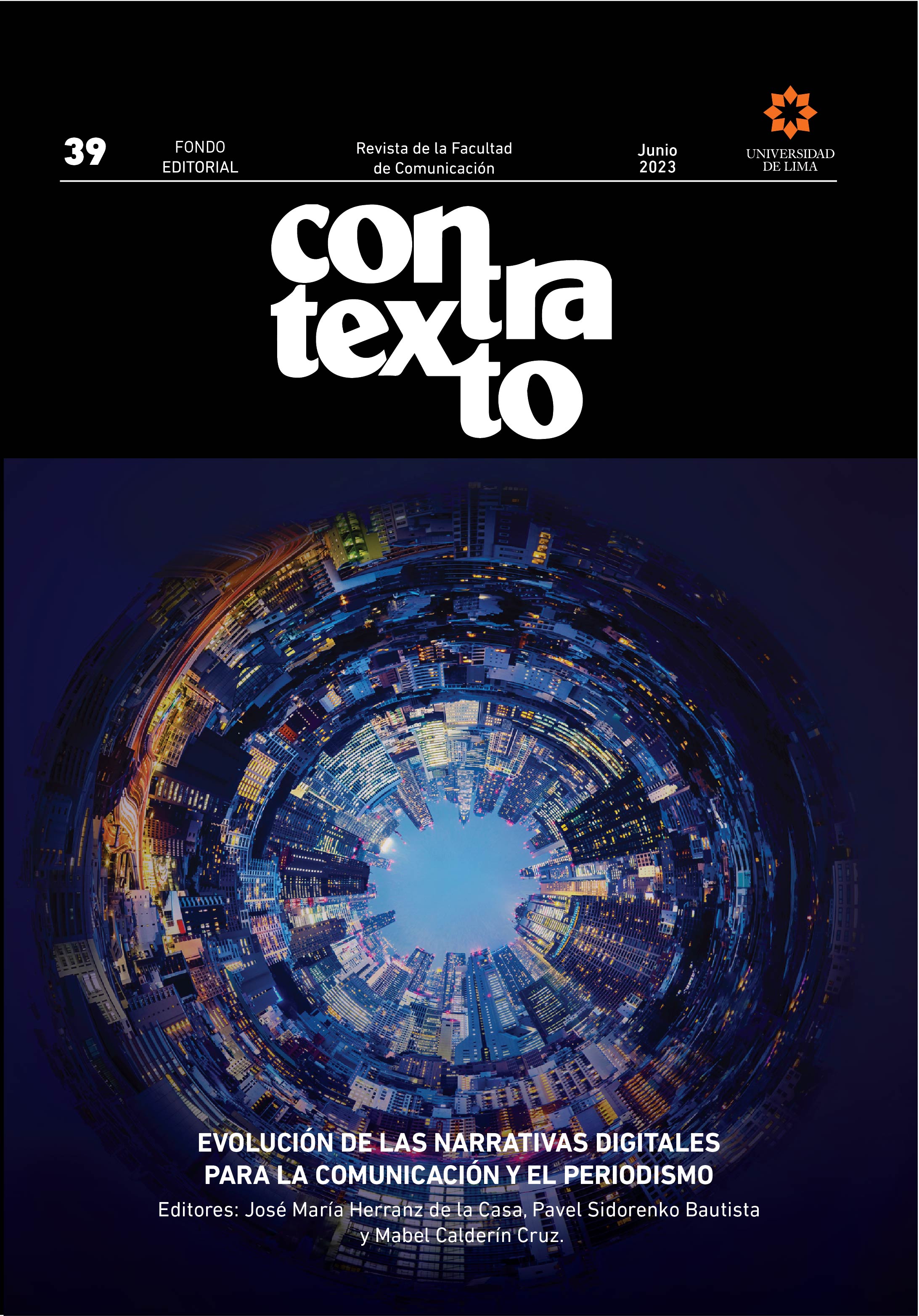The information supply by the Peruvian media during election periods and their role in strengthening democracy: a case analysis
DOI:
https://doi.org/10.26439/contratexto2023.n39.5714Keywords:
political role, framing, visibility, information supply, journalistic formatAbstract
This article analyzes the characteristics of the information supplied by the Peruvian print media in a specific election period, the 2018 regional and municipal election, and reflects on their role and contribution to democracy. For data collection, media monitoring, a quantitative technique that uses a codebook and coding sheet as instruments, was employed. A total of 3261 news items from six selected newspapers (three from Lima and three from other regions) were reviewed. This research has shown some trends or patterns of the information supplied by the selected media in the 2018 election, including the fact that the focus of the electoral process was the candidate and not the citizen; there was limited visibility of key issues, such as citizen participation in the electoral process or political party funding; most of the news about the elections was “framed” as a conflict; the news article was the most used journalistic format; and little opinion was expressed, which prevented from having broader and better debates, as well as public deliberation on issues of common interest. In addition, the study brought to light the characteristics of the information supply that question the political role of the six analyzed media and their contribution to the strengthening of democracy.
Downloads
References
Califano, B. (2015). Los medios de comunicación, las noticias y su influencia sobre el sistema político. Revista Mexicana de Opinión Pública, (19), 61-78. https://doi.org./10.1016/j.rmop.2015.02.001
Chavero, P. (2018). Mediatización de la política en los nuevos gobiernos latinoamericanos: de la confrontación a la reconciliación. Revista Internacional de Comunicación y Desarrollo, 2(8), 119-128. https://doi.org/10.15304/ricd.2.8.5149
Corporación Latinobarómetro. (2018). Informe 2018. https://www.latinobarometro.org/latContents.jsp
Dirección Nacional de Educación y Formación Cívica Ciudadana. (2022). Cambios y continuidades en las Elecciones Regionales y Municipales. Jurado Nacional de Elecciones, Fondo Editorial. https://portal.jne.gob.pe/portal_documentos/files/afb415c3-bac4-44de-b930-a77fe2991577.pdf
Graham, L. (2012). Manual de Monitoreo de Medios. Asociación de Comunicadores Sociales Calandria.
Macassi, S. (2000.). Monitoreo de medios de la primera vuelta electoral. Asociación de Comunicadores Sociales Calandria. http://www.calandria.org.pe/recursos/monitoreos_primera_vuelta_%20electoral_2000.pdf
Macassi, S. (2006). Entre la cultura política y la oferta informativa: Reflexiones sobre el debate electoral en elecciones. En R. M. Alfaro (Ed.), Indignación e incertidumbre política. Responsabilidades del periodismo en el proceso electoral (pp. 44-53). Asociación de Comunicadores Sociales Calandria.
Macassi, S. (2020). La mediatización estructural como limitante de la deliberación política. En S. Macassi (Ed.), Comunicación política y elecciones en el Perú. Avanzando en certezas (pp. 125-151). Pontificia Universidad Católica del Perú, Fondo Editorial.
Maquet, P. (2020). Agenda electoral en cuatro medios digitales durante la segunda vuelta electoral del 2016. En S. Macassi (Ed.), Comunicación política y elecciones en el Perú. Avanzando en certezas (pp. 313-340). Pontificia Universidad Católica del Perú, Fondo Editorial.
Marcos-García, S., Alonso-Muñoz, L., & López-Meri, A. (2021). Campañas electorales y Twitter. La difusión de contenidos mediáticos en el entorno digital. Cuadernos. Info, (48), 27-49. https://doi.org/10.7764/cdi.48.27679
Misión de Expertos Electorales de la Unión Europea. (2021). República del Perú. Informe Final. https://eeas.europa.eu/sites/default/files/eu_eem_per_2021_fr_es.pdf?fbclid=IwAR2pLfQ2ZDfXAEcdGMXl8fLgWcPkxTiJ_ow7tSUAHbhPWDYFRaWlnRzzl8g
Oficina Nacional de Procesos Electorales. (2018). Participación Ciudadana Elecciones Regionales y Municipales 2018. https://resultadoshistorico.onpe.gob.pe/PRERM2018/Participacion
Pedraglio, S. (2006). Balance del comportamiento informativo de los medios en procesos electorales. Elecciones en Perú: 1990, 1995, 2001 y 2005. En R. M. Alfaro (Ed.), Indignación e incertidumbre política. Responsabilidades del periodismo en el proceso electoral (pp. 11-43). Asociación de Comunicadores Sociales Calandria.
Pérez, M. (2012). Uso de redes sociales en campañas electorales [Tesis de licenciatura, Pontificia Universidad Católica del Perú]. Repositorio Institucional de la Pontificia Universidad Católica del Perú. http://hdl.handle.net/20.500.12404/1718
Ponce de León, Z., & García Ayala, L. (2019). Perú 2018: la precariedad política en tiempos de Lava Jato. Revista De Ciencia Política, 39(2), 341–365. https://doi.org/10.4067/S0718-090X2019000200341
Rojas, C. (2016). El uso de las redes sociales en el marketing político electoral: el caso de los ppkausas [Tesis de licenciatura, Pontificia Universidad Católica del Perú]. Repositorio Institucional de la Pontificia Universidad Católica del Perú. http://tesis.pucp.edu.pe/repositorio/handle/20.500.12404/6823
Tuesta, F., & Vásquez, E. M. (2016). Redes sociales en campaña presidencial. En F. Tuesta Soldevilla (Ed.), Perú: Elecciones 2016. Un país dividido y un resultado inesperado (pp. 231-258). Pontificia Universidad Católica del Perú, Fondo Editorial.
Villafranco, C. (2005). El papel de los medios de comunicación en las democracias. Andamios, 2(3), 7-21. https://doi.org/10.29092/uacm.v2i3.478
Downloads
Published
Issue
Section
License
All of the works published are licensed under a CC BY 4.0 Creative Commons Attribution license. (updated on March 1st 2021)
The content of the journal may be shared in any material or format. The content may be adapted, contributed upon and transformed. Both possibilities are only permitted in so far as they complete the following conditions:
- Attribution: Credit must be given where it is due, a link to the license must be provided and changes, if made, must be indicated. This should be done in the manner deemed appropriate, without suggesting that the licensor promotes you or your use of the material.
Ownership rights
The patrimonial rights for Contratexto are published under a Creative Commons BY 4.0 license, allowing authors to keep the patrimonial rights to their work without restrictions.
If a work published in Contratexto were to be copied, distributed, spread, or any other activities contemplated in the aforementioned license, the author(s) and the journal must be mentioned visibly and expressly.
Self-archive
This journal allows and encourages authors to post items submitted to the journal on personal websites or institutional repositories both prior to and after publication, while providing bibliographic details that credit, if applicable, its publication in this journal.


